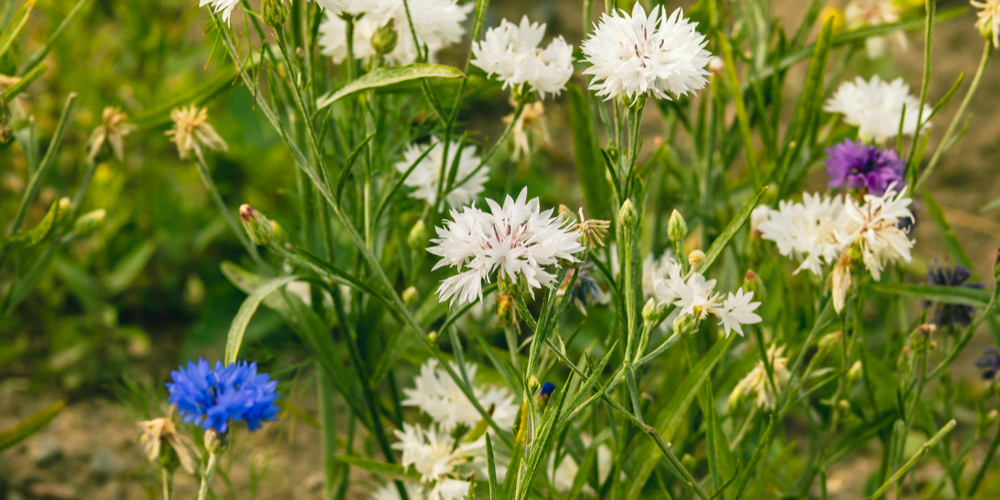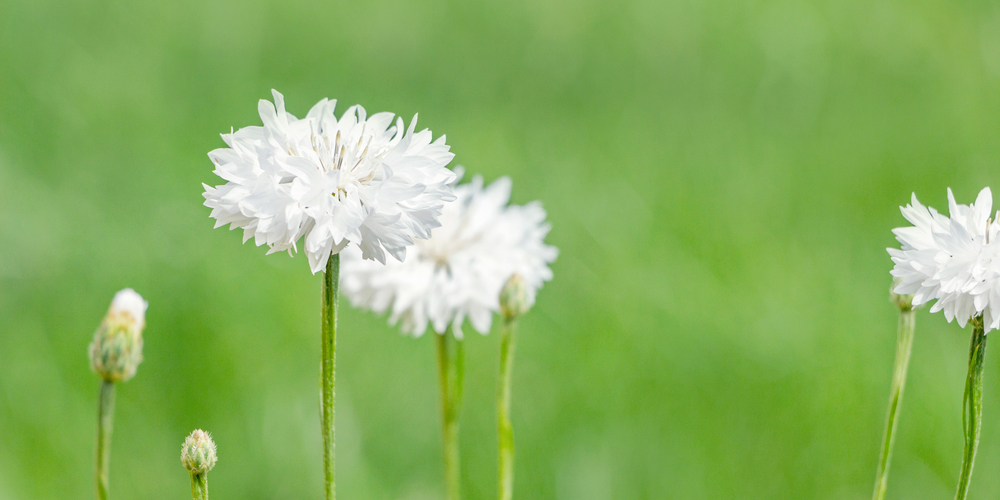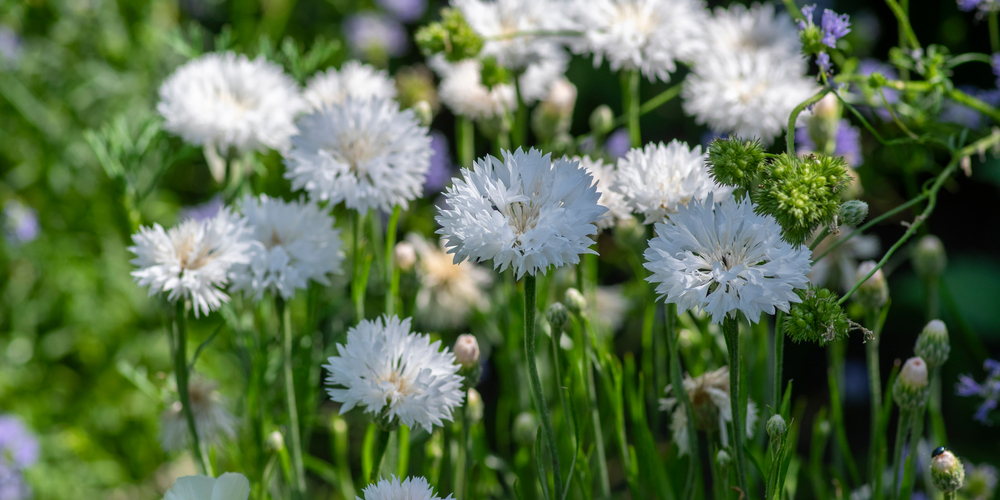White cornflowers, also known as Bachelor’s Buttons, are hardy and colorful annual plants that perform excellently as borders or in garden beds. To learn more about these attractive plants, you’ve landed in the right place. In this White Cornflower Care essential guide, you’ll get all the information you need to have them thrive in your garden.
| Botanical Name | Centaurea Cyranus |
| Common Names | White Cornflower, “Bachelor’s Buttons”, or “Bluebottle” |
| Plant Type | Annual (but can be grown as perennial in some warm regions) |
| Flower Color | 1 ½ inch large blue, pink, white, red, or purple blooms (depending on the variety) |
| Size When Mature | 12-40 inches tall
10-12 inches wide |
| Bloom Time | Late Spring to Early Fall |
| Sun Requirements | Full/ Partial Sun |
| USDA Hardiness Zones | 2-11 |
| Soil PH Range | 7.0 to 7.8 |
| Soil Type | Slightly alkaline, well-draining soil |
| Water Needs | Medium (about one inch per week) |
| Native Area | Europe |
What you Need to Know About White Cornflowers
They produce flowers from late spring into the beginning of fall and attract plenty of bees and other beneficial insects during the blooming season.
While the traditional varieties display blue-lavender delicate-looking blooms, you can find species in white, pink, red, and purple too.
Cornflowers are perfect for adding a splash of color to your garden with little effort. Indeed, these plants are easy to grow and require little attention from your side.
Native to Europe, Cornflowers are grassland plants that might display aggressive behavior if not kept under control. However, they are the ideal option for beginner gardeners looking for something to increase the looks of their yards. They are relatively easy to grow and adapt to most conditions. You can even add them as ornamentals in your vegetable garden to attract pollinators that will contribute to more voluminous yields.
During the blooming season (which lasts between early spring and late fall), these plants will release a light appealing fragrance to your garden that will make it more pleasant to spend time in your garden. Cornflowers are productive and will grow fast under optimal conditions.
If you have pets and kids running around your yard, don’t worry: cornflowers are non-toxic to humans and other animals. The plant produces edible flowers that you can use to add some color to your meals. Luckily, the entire plant is safe to eat for animals, so don’t panic if you see your dog munching on it.
How to Care for White Cornflowers
Now that you have a better idea of what White Cornflowers are, it is time to learn everything you need to know about growing and caring for a thriving White Cornflower. Pay attention to this section: here, you’ll find out tips and recommendations for having healthy cornflowers in your garden.
Light
While these plants can survive even in partial shade, they do much better under full sun. To boost flower production, ensure you pick a location for them that receives at least four hours of direct sunlight each day. Not enough light might cause your White Cornflowers to be leggy and floppy.
You can start cornflowers’ seeds indoors, but you should plant them outdoors for best results once they are ready. While they work well in containers, they need to stay outside for flower production.
Water and Soil Needs
These plants are perfect for beginners because they are not too fussy about soil conditions. Indeed, they will adapt to most environments. Give them well-draining soil for best results. To boost flower production and ensure your plant is healthy, carry out a pH test. White cornflowers prefer slightly alkaline soil conditions. If your ground is more acidic, add some limestone.
You may have to slightly change your watering schedule for this plant depending on where you live. In general, white cornflowers need about one inch of water per week. Increase the frequency during the hottest months of the year. While established plants tolerate dry soil, regular watering will keep them healthier. Avoid overwatering them, as it makes them susceptible to fungal infections. To avoid mistakes, allow the soil to dry between waterings.
Temperature Requirements
The best thing about White Cornflowers is that they grow in most environments. They tolerate light frosts and will survive even through warm and humid summers. Their versatility allows them to thrive in various climates: you can successfully plant them in hardiness zones between 2 and 11.
Fertilizer
White Cornflowers don’t need fertilizer. However, if your soil is poor, consider adding liquid manure or compost to improve the nutrient content. Add mulch around your plants to keep them moist and regulate the temperature of the ground.
Common Diseases
These plants are virtually free from pests and diseases. Watch out for aphids and mealybugs, the only insects that might cause some trouble. These plants are deer-resistant, perfect if you live next to a forest and receive frequent visits from these destructive animals.
White Cornflower Propagation
Propagating cornflowers is not a challenging task. You can do it by collecting flower heads and planting them when the time comes. You can grow new plants by planting seeds indoors about six to eight weeks before the last spring frost. Sow them in a seed tray or directly outdoors.
Prepare the soil to accommodate their growth and plant your seeds about one inch apart. Make sure the potting mix you use is rich in nutrients and well-draining. Water them thoroughly during the first few weeks: your seeds will germinate within 21 days after planting. Relocate your seedlings to other locations when they grow about four inches tall.
Alternatively, you can propagate white cornflowers by division: dig up and transplant new growth that appears in the spring.
How to Prune a White Cornflower
Pruning your plants might help you keep them healthy and prolong bloom production. Remove new growth with your fingers when your plants are about six inches tall. Depending on how fast your plants grow, you may have to repeat the process any week or so to initiate branching. When your plant reaches the density you desire, it is time to stop pinching.
Another practice to enjoy a longer-lasting flowering season is to deadhead old flowers as soon as you notice them fading. Cut the flower stem back to the next set of buds. Allowing old flowers to stay in your plant might cause your plant to focus its energies to maintain those blooms. In turn, you’ll get to enjoy fewer flowers.
Growing in Containers
You can successfully grow White Cornflowers in containers: they will enhance the look of any corner of your yard if you allow them to do so. The key to success is to use well-draining soil and a pot with drainage holes. These plants do not like too much moisture: keep the ground on the dry side if you are worried about root rot.
White Cornflowers: Final Thoughts
Mix your white cornflowers with other annuals in different colors for a more dramatic effect. Don’t forget to select a location with ideal sunlight exposure. Besides that, you won’t have to worry too much about your plants. Fertilize your cornflowers with a liquid food once per month for even more blooms.
You may also like: Hot Snow White Lobelia Care


